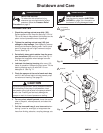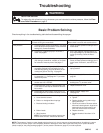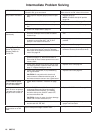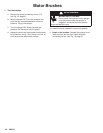
18 308715
General Repair Information
WARNING
INJECTION HAZARD
To reduce the risk of serious injury,
whenever you are instructed to relieve
pressure, follow the Pressure Relief
Procedure on page 9.
Tool List
These are the tools required to service all parts of the
sprayer.
3/16” Allenr wrench:
gear housing, legs, handle
3/8” Allenr wrench:
pump manifold
#1 Phillipsr screwdriver:
junction box,
pressure control, front cover
3/8” socket wrench:
motor mount
5/8” socket wrench:
drain valve, outlet fittings,
on/off switch boot, piston
13/16” socket wrench:
drain valve
1-1/4” socket wrench:
pump inlet valve
1/2” open end wrench:
pump rod
11/16” open end wrench:
piston jam nut
15/16” open end wrench:
flats of inlet tube
1-3/4” open end wrench:
pump jam nut
5/64” drive pin:
drain valve pin
3” needle nose pliers:
wiring, on/off switch
Hammer & punch:
packing nut
Torque wrenches:
various fasteners
WARNING
MOVING PARTS HAZARD
To reduce the risk of serious injury, in-
cluding electric shock, DO NOT touch
any moving parts or electrical parts with
your fingers or a tool while inspecting the repair.
Shut off the sprayer and unplug it as soon as you
complete the inspection.
Reinstall all covers, gaskets, screws and washers
before operating the sprayer.
WARNING
HOT SURFACE HAZARD
During operation, the motor and drive
housing become very hot and could burn
your skin if touched. Flammable materi-
als spilled on the hot, bare motor could cause a fire
or explosion
CAUTION
To reduce the risk of a pressure control malfunction,
be sure to properly mate connectors, and never pull
on a wire to disconnect it. Pulling on a wire could
loosen the connector from the wire.
1. When disconnecting wires in the junction box
assembly, use needle nose pliers to separate
mating connectors.
2. When reconnecting the wires, be sure the flat
blade of the insulated male connector is centered
in the wrap–around blade of the female
connector.
CAUTION
Improper wire routing can result in poor sprayer
performance or damage to the pressure control.
3. Route wires carefully through the drive housing
and motor. Avoid pinching the wires between the
junction box and the motor or pressure control.
4. Keep all screws, nuts, washers, gaskets, and
electrical fittings removed during repair proce-
dures. These parts are not normally provided with
replacement assemblies.
5. Test your repair before regular operation to be
sure the problem is corrected.
6. If the sprayer does not operate properly, verify
that everything was done correctly. Also refer to
the Troubleshooting Guide, pages 13–17, to help
identify other possible problems and solutions.


















